
Candlelight vigil honors victims of uranium mining and atomic testing
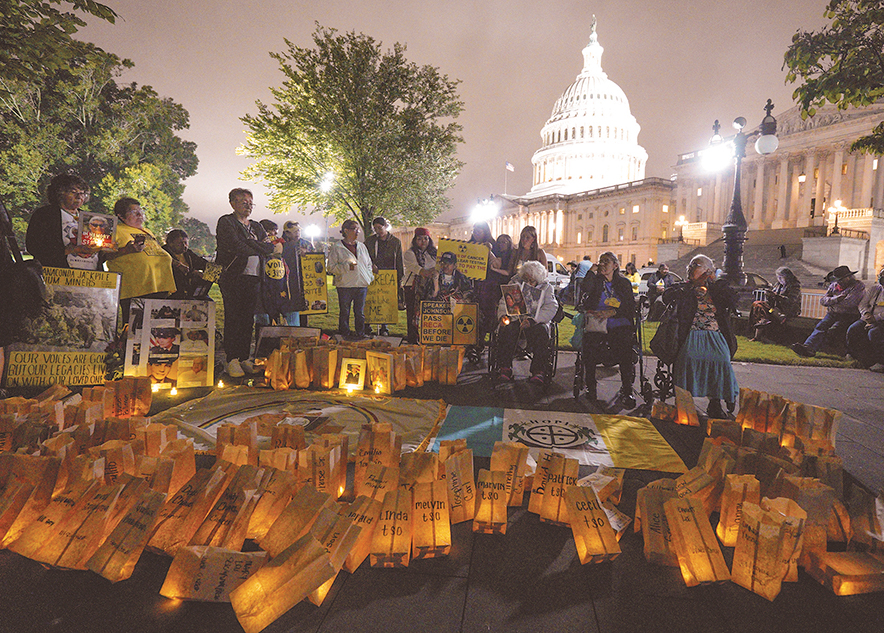
Special to the Times | Donovan Quintero
A group comprising tribal members from the Navajo Nation, Acoma Pueblo Nation, Laguna Pueblo Nation, and Hopi Tribe hold a candlelight vigil to remember their loved ones who lost their lives to uranium-related cancers. The group traveled by bus for more than 37 hours to advocate for the passage of a Radiation Exposure Compensation Act expansion bill on Sept. 25, in Washington, D.C.
By Donovan Quintero
Special to the Times
WASHINGTON, D.C. – On the evening of Sept. 25, a somber gathering took place outside the United States Capitol where former uranium miners, downwinders, advocates, family members, and friends came together to hold a candlelight vigil in memory of loved ones lost to cancer and other diseases caused by uranium mining and atmospheric nuclear testing.
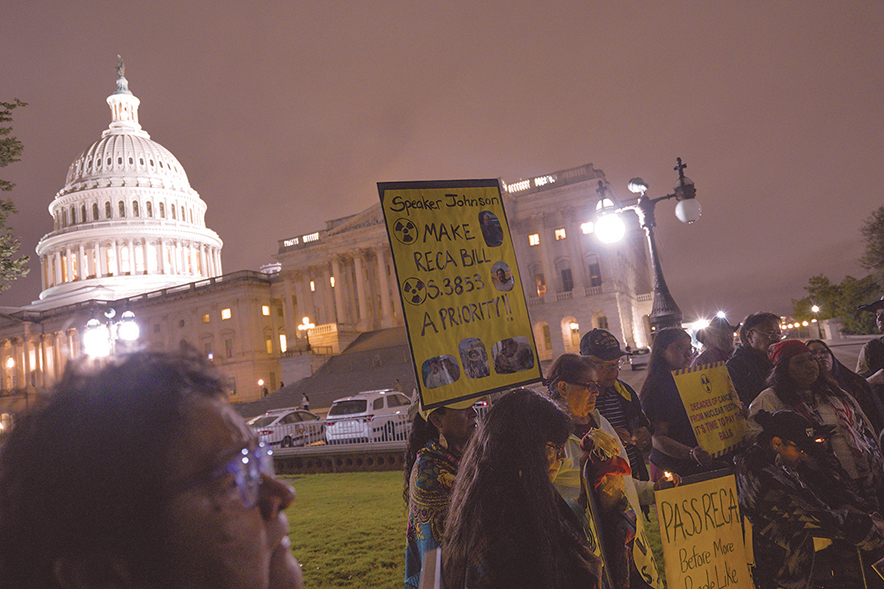
Special to the Times | Donovan Quintero
An individual holds a sign instructing House Republican Speaker Mike Johnson what to do regarding the passage of a Radiation Exposure Compensation Act expansion bill during a candlelight vigil on Sept. 25 in Washington, D.C.
The event highlighted the ongoing struggles faced by those affected by the legacy of the Cold War and called attention to the urgent need for renewed support for victims under the Radiation Exposure Compensation Act, better known as RECA.
As twilight descended upon the nation’s capital, candles flickered, some held by attendees and some placed in brown paper bags. Their warm glow symbolized hope and remembrance amid the darkness of loss. Stories were shared about the lives affected by cancer and other illnesses linked to exposure to radon gas and radioactive isotopes during uranium mining operations or as a result of living in proximity to nuclear test sites.
The vigil took on additional significance as it coincided with the expiration of RECA in July 2024. Since its enactment in 1990, the federal statute has provided monetary compensation to individuals adversely affected by the nation’s nuclear policies, including $50,000 for those living “downwind” of the Nevada Test Site, $75,000 for participants in atmospheric nuclear weapons tests, and $100,000 for uranium miners, millers, and ore transporters. Despite decades of inflation, these amounts have remained unchanged, leaving many victims and their families struggling to find adequate support.
Honoring ‘loved ones’
Evie Tsosie, from Dennehotso, Arizona, who worked as an underground uranium miner for five years at Kerr-McGee at Ambrosia Lake, said her cancer was in remission. Her father, the late David Tsosie, worked at the uranium mining site near their home and later died of lung cancer.

Special to the Times | Donovan Quintero
A group comprising tribal members from the Navajo Nation, Acoma Pueblo Nation, Laguna Pueblo Nation, and Hopi Tribe hold a candlelight vigil to remember their loved ones who lost their lives to uranium-related cancers. The group traveled by bus for more than 37 hours to advocate for the passage of a Radiation Exposure Compensation Act expansion bill on Sept. 25, in Washington, D.C.
“I didn’t know the dangers of working in uranium mines, I didn’t know how it was going to affect me, and I had to feed two kids, which I was blessed with,” she said.
Tsosie said she has gotten cancer three times — twice for breast cancer and once for colon cancer.
During the vigil, Tsosie said they were gathered to respect their loved ones who have gone into the spirit world.
“We remember them, and they suffered for us when the federal government did not tell our family that the danger, they were going to have impact upon them and our future generation and we, as cancer survivors ourselves, want to honor our loved ones,” she said. “That’s why we have our candles.”
Before the vigil, Tsosie and the survivors attended a press conference where leaders voiced their frustrations over the legislative inaction regarding the renewal of RECA.
“Since the Senate passed by an overwhelming bipartisan vote, passed our bipartisan bill with Senator (Ben Ray) Lujan and myself and others, since we passed that bill, the house has allowed this program to expire, and since that happened in June,” said U.S. Sen. Josh Hawley, who introduced a RECA expansion bill. “Since June when this program was allowed to expire, the house has been on vacation for eighty days.”
Carol Etsitty Rogers from Shiprock shared her struggles with dealing with her sickness that has spread to her family. As a child, Rogers said she and her mother would wash her father’s clothes that he had worn to work as an underground uranium miner working in Cove, Arizona.
“My mom and I, we went and washed his clothes, his work clothes, and I could see the gold coming off of his clothes, washing, wringing it out, not knowing that down the years also be affected,” said Rogers. “And I came down with cancer one day, not known that it was cancer.”
Rogers said she eventually contracted cancer in her left eye as well.
Tsosie, at the vigil, said she also lost her father to cancer.
“I’m one of the victims of having cancer. My dad died from lung cancer. My brother has cancer. My sister had cancer. I’ve been silent, wondering, keep praying something good is going to come out of this,” Tsosie said as she spoke with tears running down her cheeks.
Atomic power and weapons
The unique geology of the Navajo Nation has positioned it as a significant source of uranium, a radioactive ore that gained high demand following World War II because of the development of atomic power and weapons. From 1944 to 1986, around thirty million tons of uranium ore were extracted from this region, revealing the extent of mining operations. The Atomic Energy Commission was the primary buyer of uranium until 1966, continuing to purchase from the Navajo Nation until 1970, despite the emergence of commercial industry sales in the mid-1960s.
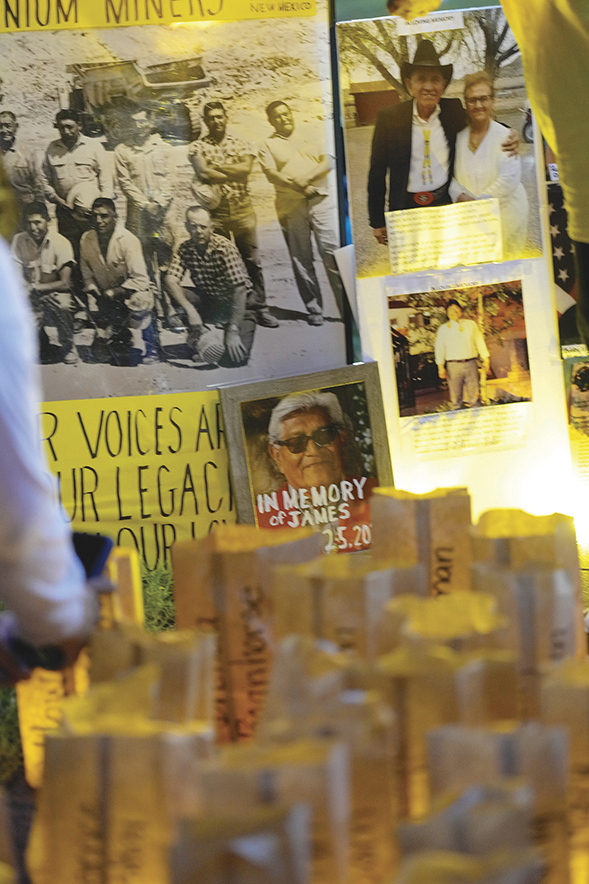
Special to the Times | Donovan Quintero
A photo of the late James Chino, a uranium miner who lost his life from cancer after working at the Jackpile-Paguate Uranium in Laguna Pueblo, N.M., during a candlelight vigil held on Sept. 25. His wife Mildred Chino, traveled to Washington, D.C., to advocate for the passage of a Radiation Exposure Compensation Act expansion bill.
Many Navajo families, including the Rogers and Tsosies, lived near the mines and processing sites, often relying on employment in these operations. Unfortunately, routine respiratory protections were not provided to the miners, resulting in devastating health consequences. The Navajo uranium miners have reported alarmingly high mortality rates from lung cancer, tuberculosis, and other serious respiratory diseases, highlighting the human cost of resource extraction in the area, according to the EPA.
Following the Cold War, the demand for uranium dwindled as federal needs for nuclear weapons decreased, leading to the abandonment of numerous mines on Navajo lands. These sites were left uncovered and unremediated, with uranium processing facilities decommissioned by the U.S. government under problematic circumstances. Radioactive mill tailings were merely capped with clay and rock, leaving behind a legacy of environmental and health hazards for surrounding communities.
Currently, there are approximately 524 identified uranium mine sites in the Navajo Nation, yet only 219 of those have allocated funds for cleanup and remediation efforts. This leaves a staggering 305 sites without any active plans to address the pollution and health risks posed to residents. The lack of action raises concerns about the enduring impacts of past mining practices and the urgent need for comprehensive environmental restoration.
1,850-mile-plus journey to nation’s capital
Tsosie, along with 31 other people impacted by uranium mining, traveled more than 1,850 miles on a bus that took 37 hours of nonstop driving — only stopping for food and fuel — across the country. They intended to spread the message that a renewal of RECA was paramount to them.
House Speaker Mike Johnson, a Republican from Louisiana, allowed the Radiation Exposure Compensation Act to expire, leaving thousands of people, including the group who traveled to D.C., without access to crucial health screenings or financial reimbursement for medical expenses related to radiation illnesses.
Despite urgent appeals from advocates, Johnson has continued declining to bring bipartisan legislation to the House floor, which had passed the Senate. The proposed bill aimed to extend RECA for six years, increase compensation levels—last updated over two decades ago—and expand coverage to include previously excluded individuals, such as victims of the first nuclear weapon detonation in New Mexico and residents living just 20 miles from the Nevada Test Site in Clarke County.
“‘Áko tʼééla. Ákoho saad beeháázdziido,” said Tsosie.
Flame flickered
The names of the deceased were read aloud, tears flowed freely among participants. And each flame that flickered represented a cherished life forever altered by the actions of the past. Candles illuminated moments of silence, punctuated by heartfelt reflections on the personal toll of radiation exposure.
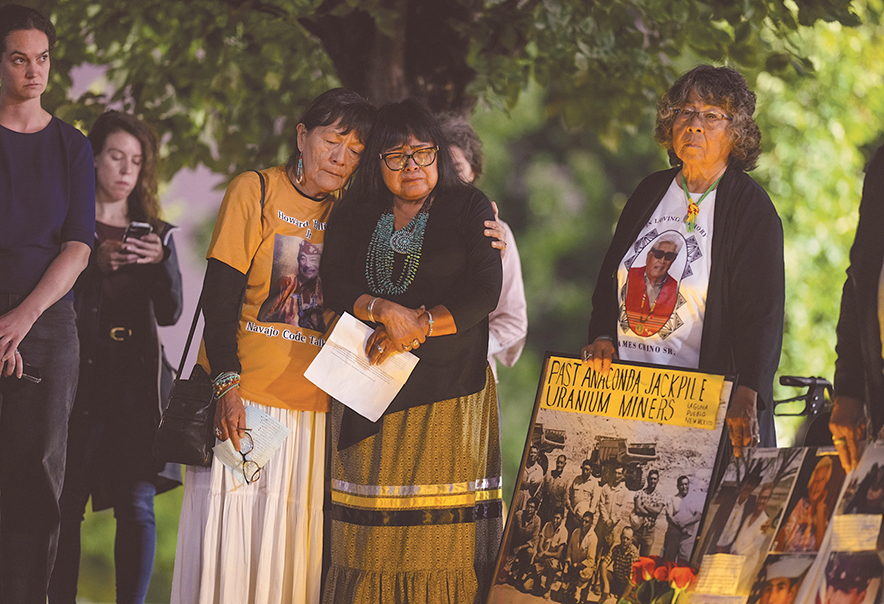
Special to the Times | Donovan Quintero
Sisters Maggie Billiman, left, and Kathleen Tsosie, console each other as they remember their late father, Navajo Code Talker Howard Billiman Jr., also a former uranium miner, who lost his life to cancer they say he got from mining for uranium. The sisters have also been dealing with the complications of cancer.
The vigil closed with a commitment to continue the fight for compensation and recognition. The gathering served not only as a memorial but also as a clarion call, urging lawmakers to act swiftly in addressing the health implications of nuclear practices and to honor the memories of those whose lives were irrevocably changed by uranium mining and testing.
In a direct appeal for support, the attendees also visited the speaker who has faced criticism for blocking the RECA bill by refusing to bring it to the floor for a vote. The group presented Johnson’s staff with a staggering $7.4 million in medical bills, representing the cumulative expenses incurred by the victims of these historical injustices.
One poignant voice among the survivors was Kathleen Tsosie, whose medical bills alone totaled $390,620. In her invoice, Tsosie highlighted her experience as a two-time breast cancer survivor.
Frustrated and unheard, fight not over
Despite their efforts, Johnson’s staff informed Kathleen and her group that he was not in the office at the time of their visit, leaving many feelings frustrated and unheard.
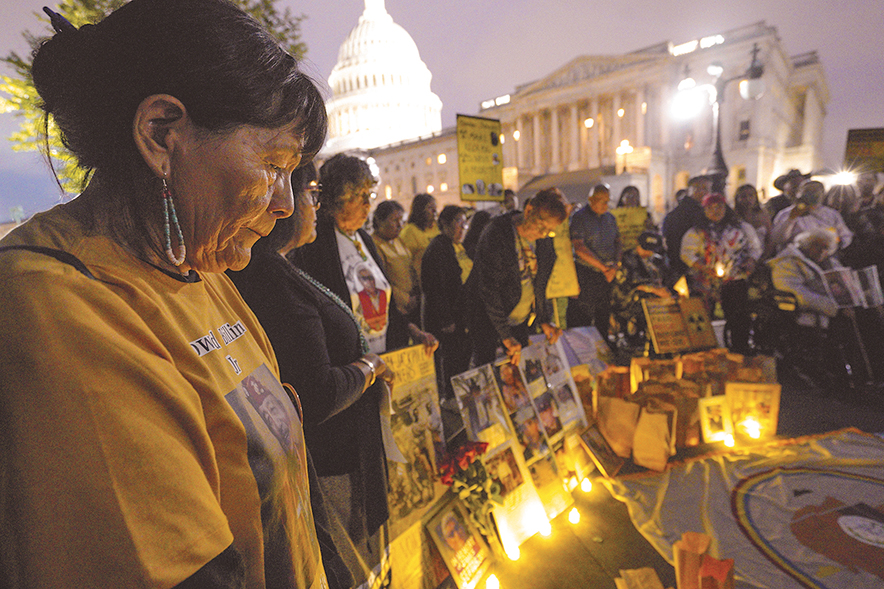
Special to the Times | Donovan Quintero
Maggie Billiman, left, becomes emotional as she remembers her late father Navajo Code Talker Howard Billiman Jr., during a candlelight vigil in Washington, D.C.
“I’m still having ongoing treatments. Mike Johnson, please pass the RECA Bill for me! Bills need to be paid. I finished my radiation four weeks ago. Living with side effects,” she wrote, pleading for action.
Rogers also gave her medical bill to Johnson which totaled $307,260. Two of which in surgery and cancer treatment amounted to $300,000.
Evie Tsosie’s medical bill amounted to $450,000, from surgery, oncology and hematology, medication, and visits to the doctor.
She wrote on her bill that she’d been diagnosed three times with cancer at different periods.
“The latest was 2021,” she wrote on her medical bill.
One of the medical bills from Louisa Martinez wrote on the medical bill that payment was “immeasurable.”
“My Mother, Louisa Martinez, saw many, many people die from cancer in Tularosa. So, when she was diagnosed, she went home to die. Over the next three months, she lost all her body weight as tumors grew all over her body. She died choking on a morphine pill because she was too weak to swallow. It was a pill sent from God because it ended her suffering. Just the night before she died, I listened to her crying to her mother for mercy. No one should have to hear their mother cry to her mother for relief from pain,” the statement read on the medical invoice.
The RECA program has compensated affected individuals since its inception in 1990, but the amounts have remained unchanged despite inflation. Yet beneficiaries must navigate complex requirements to prove exposure, establish the duration of employment, and demonstrate specific medical conditions, making the process daunting for many needing assistance.
When the group arrived back in Albuquerque on Saturday afternoon, they told one another the fight for RECA was not over.

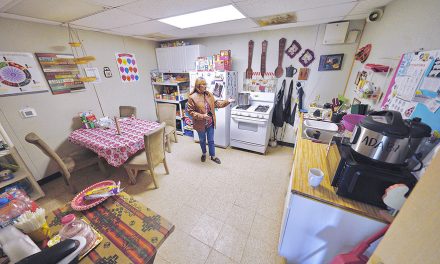
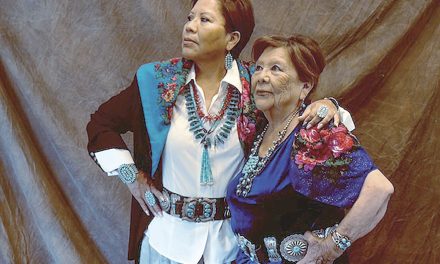
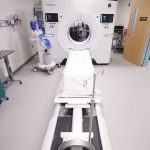
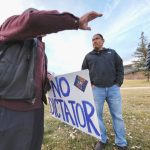



 Highway 264,
Highway 264, I-40, WB @ Winslow
I-40, WB @ Winslow